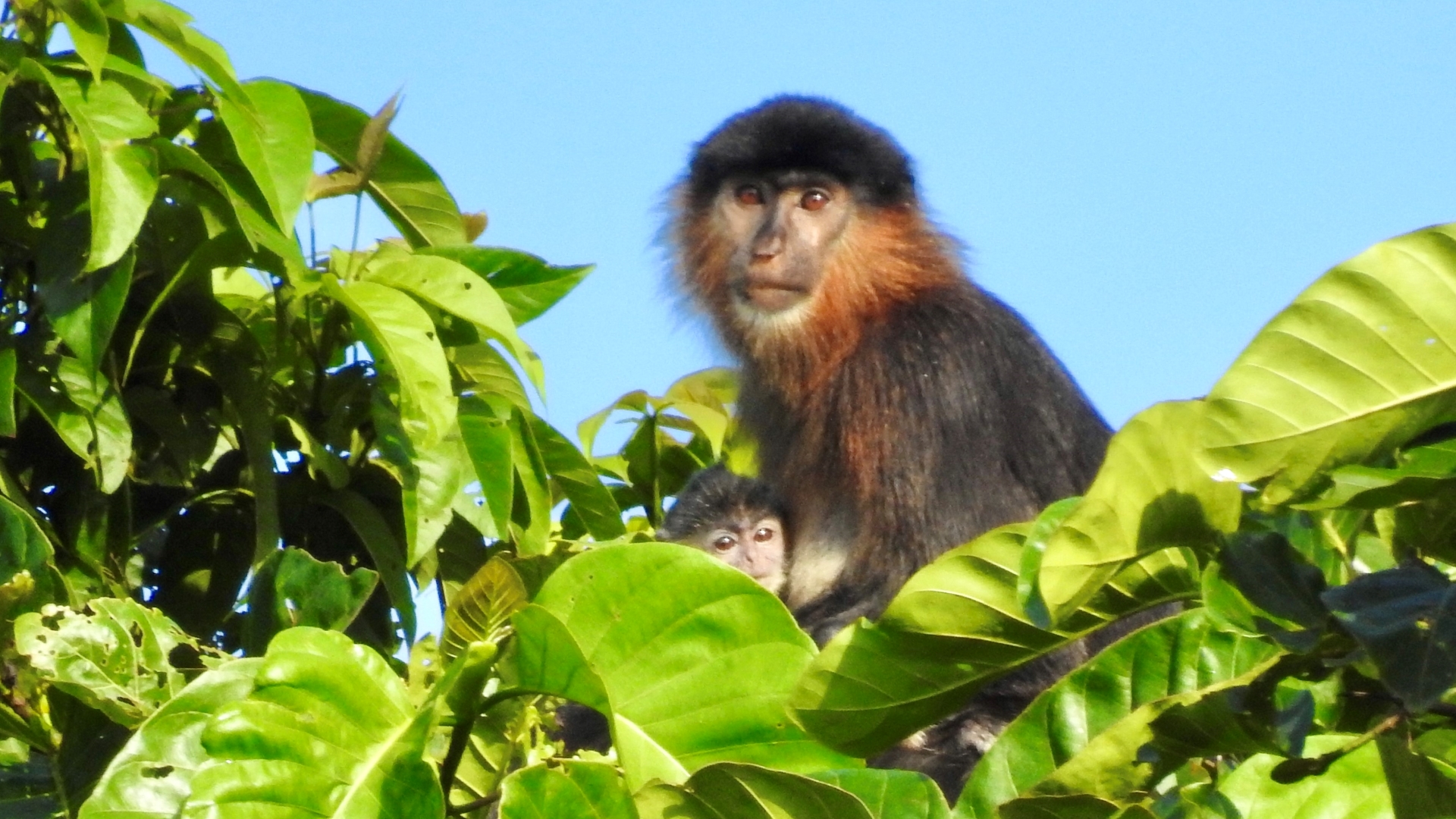Borneo has a hybrid 'mystery monkey,' and researchers are concerned
The monkey shows characteristics from two different species.

An unidentified monkey spotted in Borneo is a rare hybrid between two different species that are competing for forest space, a new study suggests.
Researchers concluded that the "mystery monkey" is likely the offspring of a proboscis monkey (Nasalis larvatus) and a silvery langur (Trachypithecus cristatus) — two distantly related species that share the same habitat.
Coronavirus restrictions prevented the researchers from investigating the forest where the monkey lives, so instead the scientists analyzed photos that began appearing on social media in 2017. The monkey was initially photographed as a juvenile, but more recent photos from 2020 reveal that the animal is now a mature female and may have an infant of her own.
"She appeared to be nursing a baby," study co-author Nadine Ruppert, a primatologist at the Universiti Sains Malaysia (Science University of Malaysia), told Live Science in an email. "We were all in awe, it was quite surreal."
Related: These endangered monkeys kept getting hit by cars. Scientists had a clever solution.
While different species typically don't produce viable offspring if they mate, very closely related species may occasionally interbreed in the wild to create hybrids. For example, northern pig-tailed macaques (Macaca leonina) and southern pig-tailed macaques (Macaca nemestrina) interbreed in certain parts of Thailand, according to the International Union for Conservation of Nature (IUCN). However, interbreeding species are typically similar and belong to the same evolutionary group, or genus — proboscis monkeys and silvery langurs do not.
The hybrid monkey was spotted near the Kinabatangan River in Malaysian Borneo (the island is divided among three nations: Malaysia, Brunei and Indonesia), where the ranges of proboscis monkeys and silvery langurs overlap. But these two monkey species are visibly very different.
Get the world’s most fascinating discoveries delivered straight to your inbox.
Adult proboscis monkeys have pinkish faces with elongated noses, while adult silvery langurs have black faces with shorter, flatter noses. Probosicis monkeys are also larger. A male proboscis monkey can grow up to 30 inches (76 cm) long and weighs 44 to 53 pounds (20 to 24 kg). Silvery langurs only reach about 22 inches (56 cm) long and weigh 14.5 pounds (6.6 kg) on average, according to the New England Primate Conservancy.


Both species live in groups composed of a dominant male and multiple females and their offspring. Males born into these groups are pressured to leave once they mature to start groups of their own, or take over another group. However, habitat decline is limiting the areas where these dispersing males can go, according to Ruppert.
"We concluded from the observations that the photographers made that male proboscis monkeys are mating with female silver langurs in the area and that there are mixed groups where female proboscis monkeys even take care of silver langur babies," Ruppert said.
Male proboscis monkeys may be using their larger size to oust langur males and take over langur groups. The researchers suspect that the "mystery monkey" in the photos is the offspring of a male proboscis monkey and a female langur because it shares characteristics of both species. For example, her nose is pronounced like a female proboscis monkey, but not as elongated, and her face has a gray tinge.
Most hybrids born from different species are sterile and unable to produce offspring, which makes the so-called mystery monkey and her baby even more unusual. It's possible she was allomothering — or taking care of another female's infant — but the photos showed that she had swollen breasts associated with lactation, which indicates the offspring was her own.
As unique and intriguing as the discovery appears to be, there's a downside. "It’s tragic that both species now cramp together in the remaining narrow riparian forest patches surrounded by oil palm plantations, where they compete for food and mating opportunities," Ruppert said. "I hope that people will start talking about her, not as an attraction, but as a 'flagship' animal of the area that needs to be protected, and with her, her two parent species and their habitat."
The study was published April 26 in the International Journal of Primatology.
Originally published on Live Science.

Patrick Pester is the trending news writer at Live Science. His work has appeared on other science websites, such as BBC Science Focus and Scientific American. Patrick retrained as a journalist after spending his early career working in zoos and wildlife conservation. He was awarded the Master's Excellence Scholarship to study at Cardiff University where he completed a master's degree in international journalism. He also has a second master's degree in biodiversity, evolution and conservation in action from Middlesex University London. When he isn't writing news, Patrick investigates the sale of human remains.


